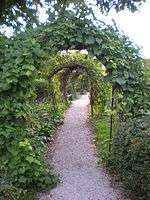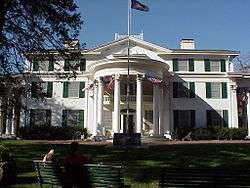Arbor Lodge State Historical Park and Arboretum
|
Arbor Lodge | |
|
The front of Arbor Lodge. | |
| Nearest city | Nebraska City, Nebraska |
|---|---|
| Coordinates | 40°40′50″N 95°52′54″W / 40.68056°N 95.88167°WCoordinates: 40°40′50″N 95°52′54″W / 40.68056°N 95.88167°W |
| Area | 72 acres (29 ha) |
| Built | 1855 |
| Architect |
Jarvis Hunt (house) Frederick Law Olmsted (grounds) |
| Architectural style | Colonial Revival |
| NRHP Reference # | 69000135 |
| Significant dates | |
| Added to NRHP | April 16, 1969[1] |
| Designated NHL | May 15, 1975[2] |
Arbor Lodge State Historical Park and Arboretum is a mansion, state park, and arboretum located at 2300 2nd Avenue, Nebraska City, Nebraska, U.S. The Park's grounds are open daily; the mansion is open daily between April and December.
Overview

Today's 52-room neo-colonial house began in 1855 for J. Sterling Morton, originator of Arbor Day and Secretary of Agriculture in the 1890s under President Grover Cleveland. The house was originally a modest 4-room frame structure on 160 acres (65 ha). It was extended several times, most recently in 1903, and in later years served as the summer home for his son Joy Morton, namesake of Morton Salt Company. The mansion features Victorian and Empire furnishings, many of which were owned by the Mortons. Its sun parlor contains a fine Tiffany skylight with grape wreath design.
The mansion currently functions as a museum and contains many items related to the early history of Nebraska, Otoe County, and Nebraska City (which was founded in 1854). A nearby outbuilding contains early carriages, steam-driven vehicles, fire wagons, and gasoline-driven vehicles.
Trees were a central interest of J. Sterling Morton. He imported trees from all over the world in order to test their suitability to create windbreaks and otherwise break up the monotony of the great plains. The house is surrounded by 270 varieties of trees and shrubs, including gardens, apple orchards, and acres of oaks, maples, chestnuts, and pines, including at least 10 state-champion trees. Specimen trees are typically labeled with engraved bronze plates. Over the years, many of Arbor Lodge's apple orchards were demolished, but in the 1990s their restoration began with plantings of Winesaps, Golden Delicious, Red Delicious, Jonathans, and Jonadels.
Gallery
-

Arbor Lodge looking from the old brick road.
-

Southeastern view of Arbor Lodge
-

View of the south side of the mansion from the rose garden.
-

Pathway in the rose garden on the south side of the mansion
-

The Tiffany skylight in the sun parlor.
See also
- List of botanical gardens in the United States
- National Register of Historic Places listings in Otoe County, Nebraska
References
- ↑ National Park Service (2006-03-15). "National Register Information System". National Register of Historic Places. National Park Service.
- ↑ "Morton, J. Stirling, House". National Historic Landmark summary listing. National Park Service. Retrieved 2008-06-27.
External links
- Arbor Lodge State Historical Park Nebraska Game and Parks Commission
